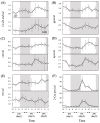Diurnal-Rhythmic Relationships between Physiological Parameters and Photosynthesis- and Antioxidant-Enzyme Genes Expression in the Raphidophyte Chattonella marina Complex
- PMID: 39061850
- PMCID: PMC11274130
- DOI: 10.3390/antiox13070781
Diurnal-Rhythmic Relationships between Physiological Parameters and Photosynthesis- and Antioxidant-Enzyme Genes Expression in the Raphidophyte Chattonella marina Complex
Abstract
Diurnal rhythms in physiological functions contribute to homeostasis in many organisms. Although relationships between molecular biology and diurnal rhythms have been well studied in model organisms like higher plants, those in harmful algal bloom species are poorly understood. Here we measured several physiological parameters and the expression patterns of photosynthesis-related and antioxidant-enzyme genes in the Chattonella marina complex to understand the biological meaning of diurnal rhythm. Under a light-dark cycle, Fv/Fm and expression of psbA, psbD, and 2-Cys prx showed significant increases in the light and decreases during the dark. These rhythms remained even under continuous dark conditions. DCMU suppressed the induction of psbA, psbD, and 2-Cys prx expression under both light regimes. Oxidative stress levels and H2O2 scavenging activities were relatively stable, and there was no significant correlation between H2O2 scavenging activities and antioxidant-enzyme gene expression. These results indicate that the Chattonella marina complex has developed mechanisms for efficient photosynthetic energy production in the light. Our results showed that this species has a diurnal rhythm and a biological clock. These phenomena are thought to contribute to the efficiency of physiological activities centered on photosynthesis and cell growth related to the diurnal vertical movement of this species.
Keywords: Chattonella marina complex; antioxidant enzyme; diurnal rhythm; photosynthesis.
Conflict of interest statement
The authors declare no conflict of interest.
Figures







References
-
- Hallegraeff G.M., Munday B.L., Baden D.G., Whitney P.L. Chattonella marina Raphidophyte bloom associated with mortality of cultured bluefin tuna (Thunnus maccoyii) in South Australia. In: Reguera B., Blanco J., Fernandez M.L., Wyatt T., editors. Harmful Algae. Xunta de Galicia; A Coruña, Spain: IOC of UNESCO; Paris, France: 1998. pp. 93–96.
-
- Elbraechter M. Exotic flagellates of coastal North Sea waters. Helgoländer Meeresunters. 1999;52:235–242. doi: 10.1007/BF02908899. - DOI
-
- Onitsuka G., Aoki K., Matsuyama Y., Kimoto K., Matsuo H., Kitadai Y., Nishi H., Tahara Y., Sakurada K. Short-term dynamics of a Chattonella antiqua bloom in the Yatsushiro Sea, Japan, in summer 2010: Characteristics of its appearance in the southern area. Bull. Jpn. Soc. Fish. Oceanogr. 2011;75:143–153.
-
- García-Mendoza E., Cáceres-Martínez J., Rivas D., Fimbres-Martinez M., Sánchez-Bravo Y., Vásquez-Yeomans R., Medina-Elizalde J. Mass mortality of cultivated Northern bluefin Tuna Thunnus thynnus orientalis associated with Chattonella species in Baja California, Mexico. Front. Mar. Sci. 2018;5:454. doi: 10.3389/fmars.2018.00454. - DOI
Grants and funding
LinkOut - more resources
Full Text Sources

